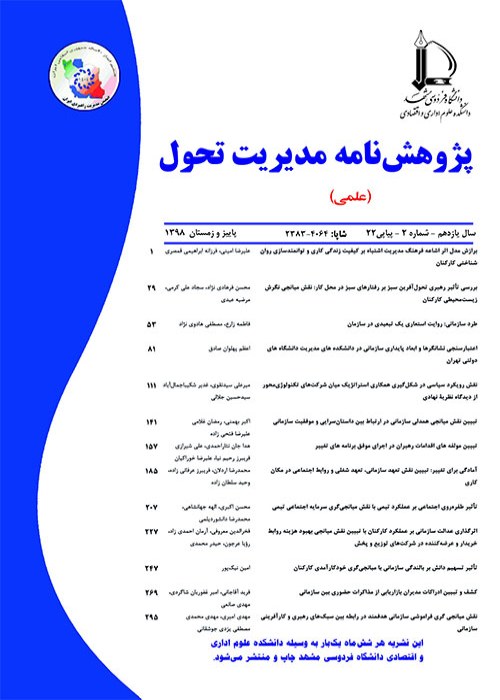Exploring the Conceptual Components of Organizational Silence and their Affecting Factors: a Mixed-methods Study
Although employees' voice than their silence is more valuable to organizations in today's competitive and changing world, many employees prefer silence. Therefore, the organization is not capable of investigating and correcting its errors, which refers to a problem called organizational silence. In the experts’ opinion, if employees' mouths are silenced the minds of organizations producing organizational knowledge will be fossilized. Determining the organizational silence is much more complicated than identifying behaviors such as absenteeism or sabotage. Therefore, the question is that how the organizational silence is determined and what factors are considered signals for organizational silence. In this regard, the present study identifies the components of organizational silence and factors affecting these components.
THEORETICAL FRAMEWORK:
Despite a 50-year time period of interest in identifying the concepts of organizational silence and voice, investigations indicated that most studies had focused on how employees' silence is formed and its causes. However, the organizational silence is beyond these concepts and more in-depth studies are needed to be understood. Organizational silence is a social phenomenon in which employees refuse to express their views and concerns about organizational problems. Silence does not mean not talking, not writing, or the like, but fleeting speeches and writings of no identity, trust, and authority. This phenomenon has destructive consequences for organizations, such as employees' worthlessness, reduced trust, motivation, satisfaction, commitment, and creativity, job turnover, lack of efficiency in organizational change processes, and flattery and distortion of reality. Organizational silence has diverse indices such as employees’ reluctance to talk about work issues, lack of sharing work information, fear of misunderstanding, absenteeism, not listening, having a negative approach, indifference to the organization affairs, constant negligence at work, unwillingness to convey bad news to top management, and Hiding problems due to fear of being victimized.
This research is a mixed-methods study. In the qualitative phase, by conducting a content analysis on literature, the most important signs of organizational silence and its affecting factors were extracted. These signs were provided to 10 Delphi members for identifying the components of organizational silence. Among the eight identified characteristics, according to the experts’ opinions, six characteristics were finally selected as components of organizational silence. A 24-item Items questionnaire was designed for these components. Lavache’s content validity ratio (CVR) was used to evaluate the questionnaire’s validity. Since the calculated CVR values for all the items were greater than 0.62, the questionnaire’s validity was satisfactorily confirmed. The Cronbach's alpha coefficient of 0.731 also indicated its adequate reliability.
Out of eight characteristics identified for organizational silence, six components were finally selected as its components: Flattery, constant nagging and complaining about the situation, yes-manship, indifference to assigned tasks, decreased willingness to participate in none-compulsory activities, feeling frustrated and bored. In the second phase of Delphi, out of 11 identified factors, six were selected as the affecting factors: authoritarian and patriarchal leadership style, repressive organizational culture, low organizational commitment, bureaucratic and cumbersome rules and procedures, conservative personality of managers, tall organizational structure. In addition, five important consequences of organizational silence were identified to be the reduced effectiveness of organizational decisions, resistance to change, blocking the path of providing feedback, lack of analysis of ideas, increased dissatisfaction, and decreased organizational motivation. According to these findings and back to the research literature, adopting a systemic approach, the conceptual model of organizational silence was proposed.
CONCLUSIONS & SUGGESTIONS:
What the clear is that, contrary to many people's beliefs, organizational silence has adverse effects on both the organization and employees. Indifferent employees resulted from ignoring their silence promote the mindset of being indifferent. As a result of such an attitude, employees will suffer from depression and other wellbeing problems. Organizational silence increases their stress and makes them feel guilty and overwhelmed by psychological problems.
- حق عضویت دریافتی صرف حمایت از نشریات عضو و نگهداری، تکمیل و توسعه مگیران میشود.
- پرداخت حق اشتراک و دانلود مقالات اجازه بازنشر آن در سایر رسانههای چاپی و دیجیتال را به کاربر نمیدهد.


